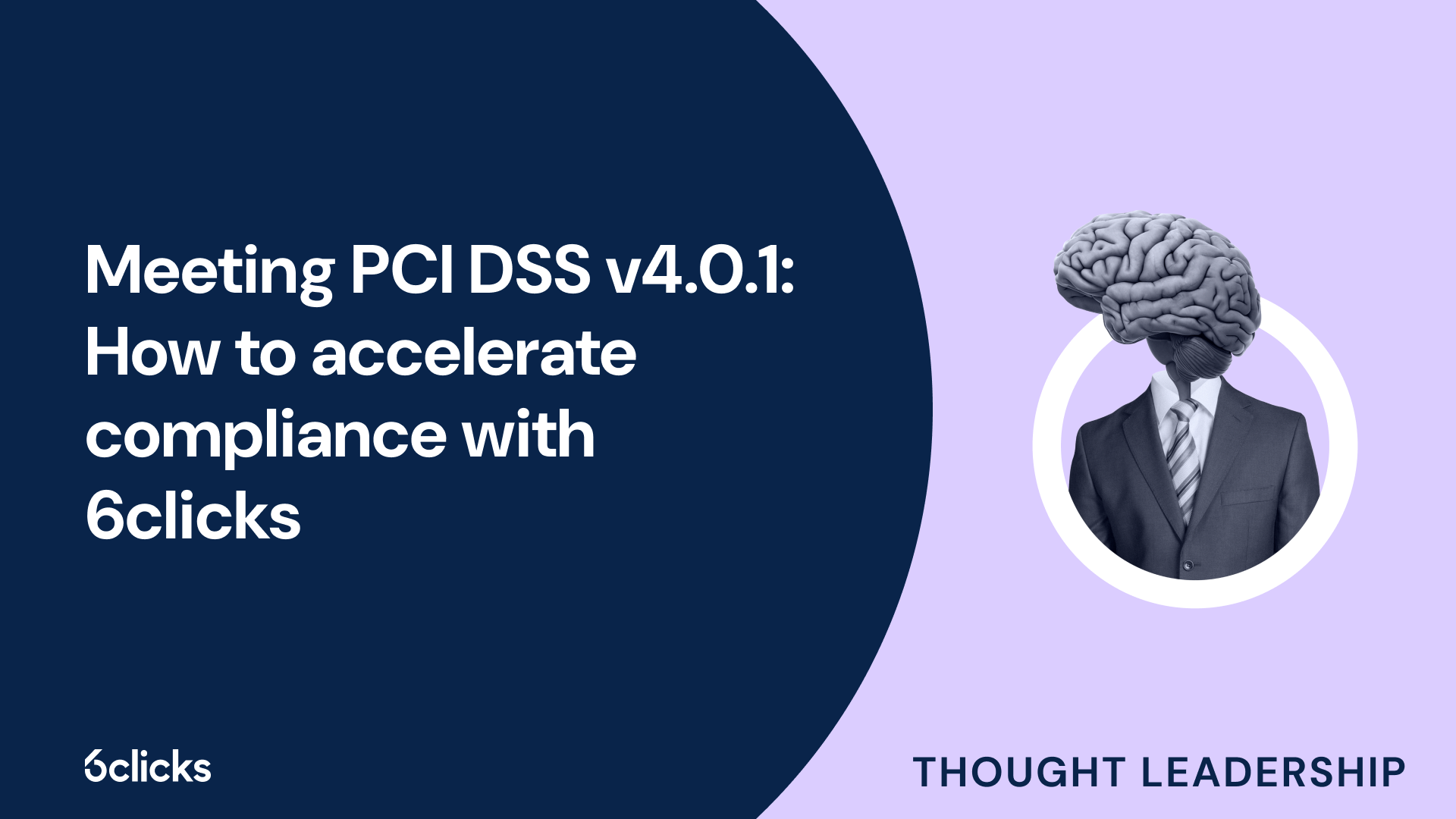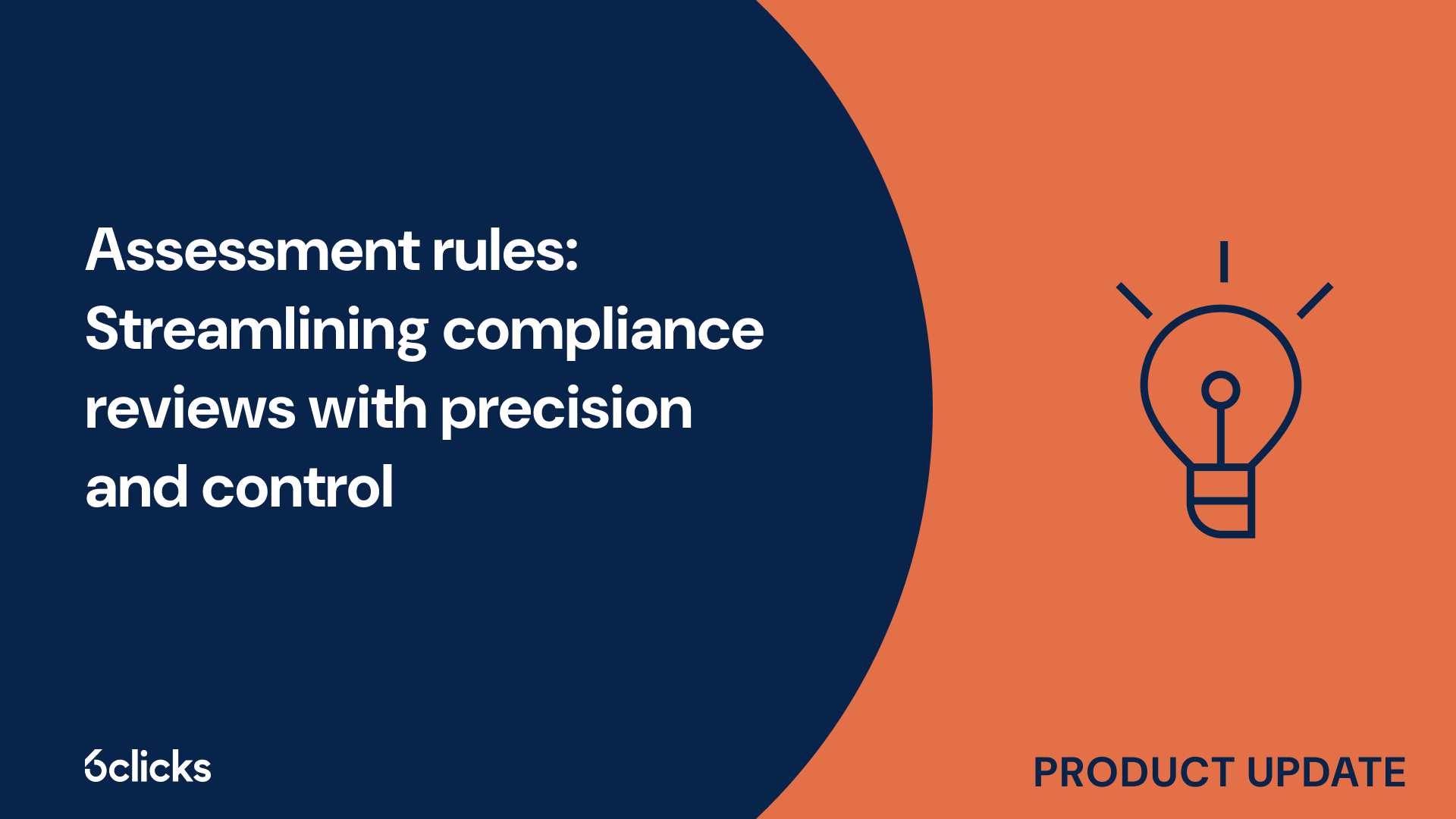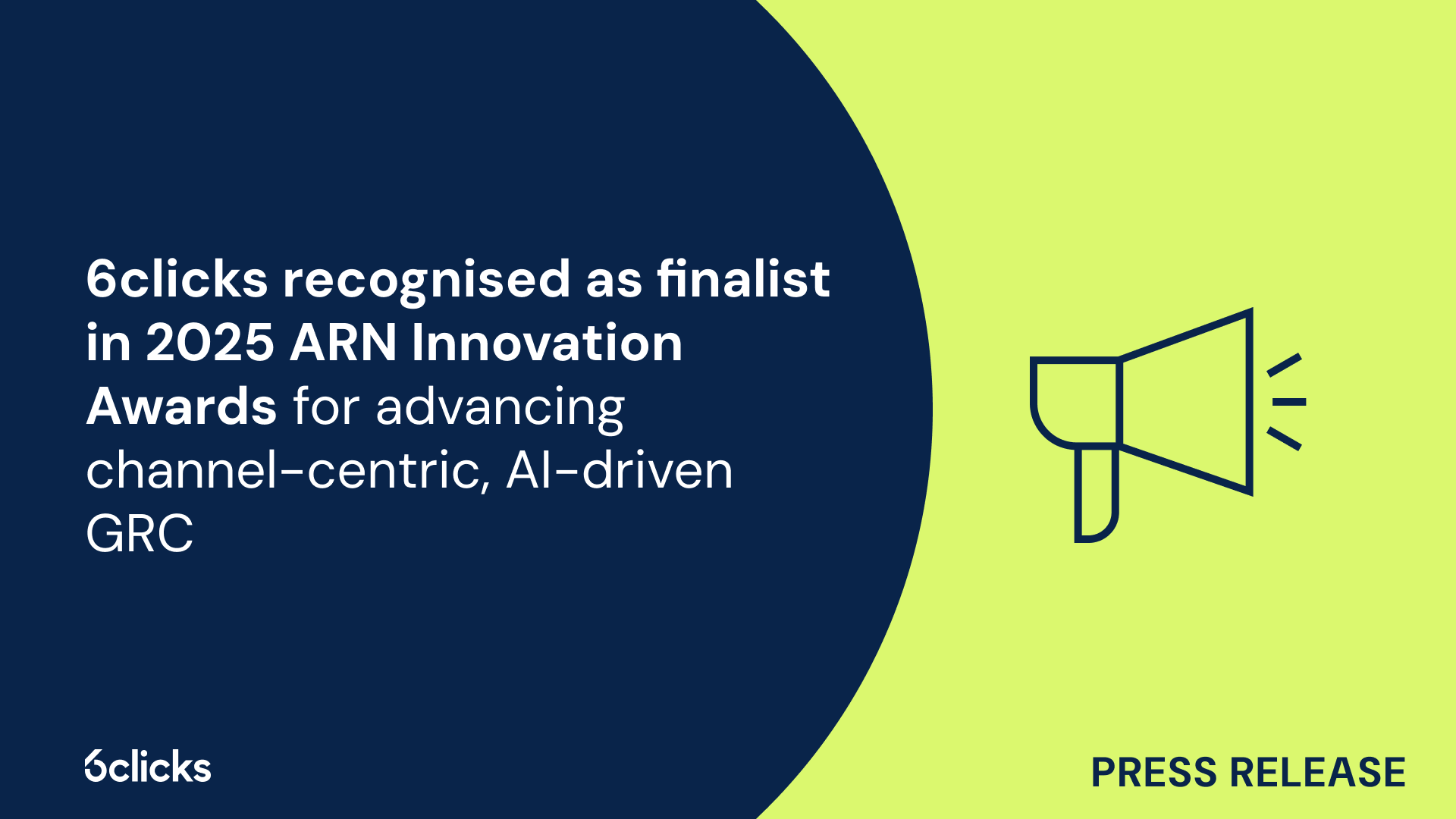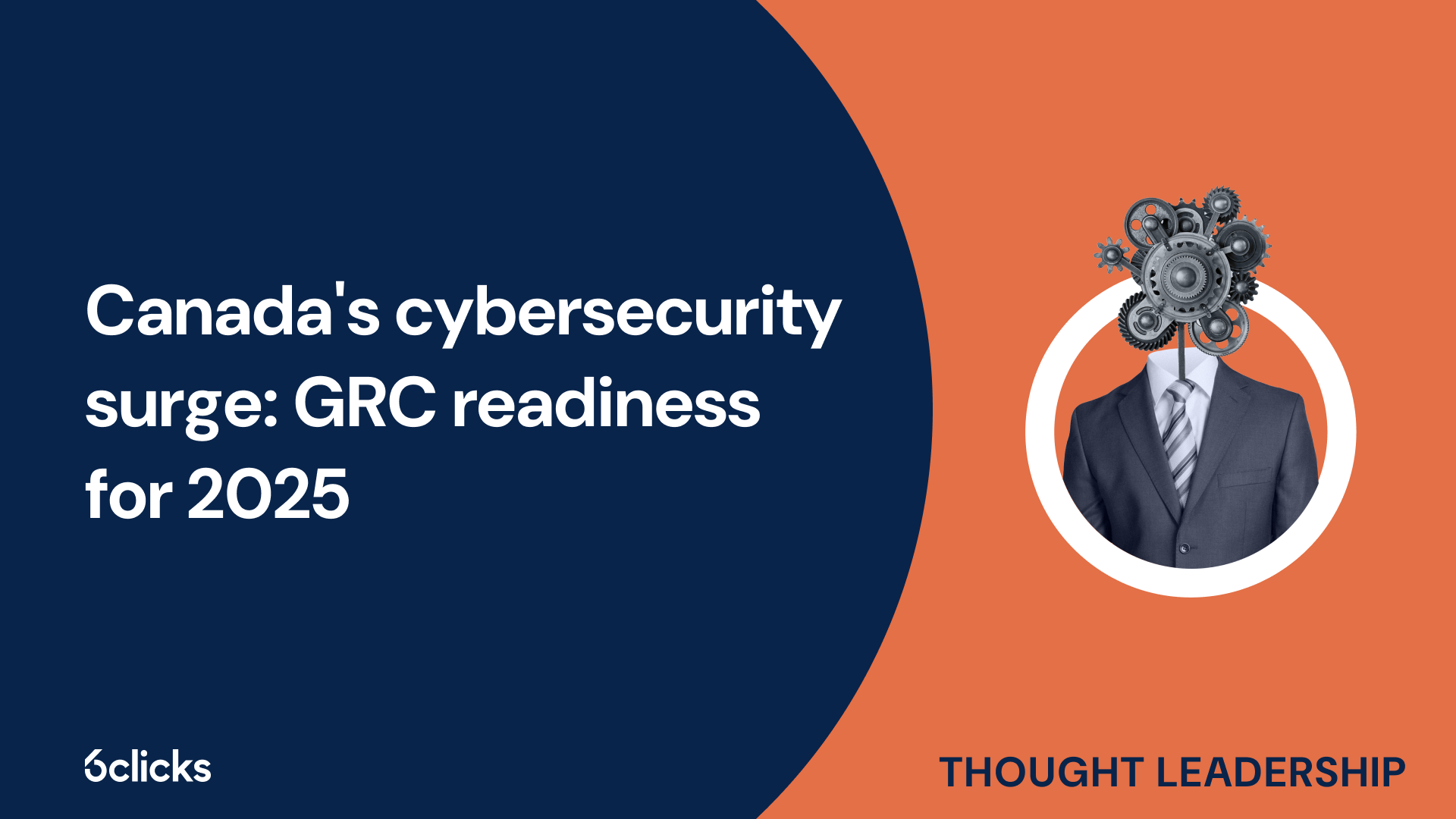The GRC buyer’s guide for 2025: Building resilience with AI-powered, federated solutions
Discover the ultimate GRC buyer's guide for 2025! Uncover how AI-powered, federated solutions transform compliance and security management for industries like government, aerospace, banking, and more. Learn about centralized control, continuous compliance, and advanced cyber GRC capabilities. Download now!
-1.png?width=200&height=249&name=Group%20193%20(1)-1.png)
The GRC buyer’s guide for 2025: Building resilience with AI-powered, federated solutions
Definition of enterprise risk management (ERM)
Enterprise risk management (ERM) refers to the comprehensive approach that an organization takes to identify, assess, and manage all types of risks that could impact its business objectives. It involves the systematic management of potential risks, both internal and external, across all levels of the organization. ERM aims to provide a structured framework that enables the organization to anticipate and respond proactively to potential risks, rather than simply reacting to them after they have occurred. By implementing ERM, organizations can gain a holistic understanding of the risks they face, make informed decisions about risk appetite and tolerance, and develop effective risk management processes and strategies. ERM encompasses various aspects such as financial risk, operational risk, strategic risk, compliance risk, reputational risk, and more. It involves key stakeholders, including the board of directors, senior management, business leaders, risk owners, and the enterprise risk management team, who collectively have the responsibility of overseeing the organization's risk management activities.
Who is responsible for ERM process?
In the enterprise risk management (ERM) process, various stakeholders play crucial roles and carry specific responsibilities to effectively manage risks within the organization. The board of directors, senior management, and the enterprise risk management team (ERMT) are key stakeholders responsible for overseeing and implementing ERM.
The board of directors holds overall responsibility for managing risk within the organization. They define the risk appetite and establish risk tolerances, aligning them with the strategic goals and business objectives. The board also ensures that risk management processes and systems are in place, and that appropriate risk responses are implemented.
Senior management is responsible for operationalizing ERM within the organization. They establish an enterprise risk management framework that encompasses the identification, assessment, monitoring, and management of risks. Senior management ensures that risks are integrated into the decision-making process and that risk management activities are aligned with the strategic objectives.
The enterprise risk management team (ERMT) supports the board and senior management in managing risks. They are responsible for facilitating risk assessments, identifying critical risks, and developing risk mitigation strategies. The ERMT monitors risk exposure and provides regular updates to the board and senior management. They also assist in the establishment of risk management processes and policies, ensuring compliance and promoting a robust risk culture within the organization.
Collectively, these stakeholders collaborate to develop a comprehensive approach to risk management. Their collaboration enables effective risk oversight and management throughout the organization, ensuring that potential risks are evaluated, and appropriate measures are taken to mitigate them.
Board of directors
The board of directors plays a crucial role in managing risk within an organization. With overall responsibility for overseeing and governing the organization, the board sets the tone for risk management and establishes the risk appetite and tolerances. In this article, we will explore the specific responsibilities and importance of the board of directors in effectively managing risk.
- Definition of Risk Appetite and Risk Tolerances: The board of directors is responsible for defining the organization's risk appetite – the level of risk the organization is willing to accept in pursuit of its strategic goals. They also establish risk tolerances, which define the threshold at which certain risks become unacceptable. These decisions provide the foundation for the risk management processes and strategies implemented throughout the organization.
- Alignment of Risk Management with Strategic Goals: The board ensures that risk management is aligned with the organization's strategic goals and objectives. By incorporating risk considerations into the strategic planning process, the board helps prioritize risks and identifies potential threats that may hinder the achievement of strategic objectives. This alignment ensures that risk management efforts are focused on protecting and enhancing the organization's long-term success.
- Establishment of Risk Management Processes and Systems: The board of directors is responsible for ensuring that effective risk management processes and systems are in place. This involves establishing policies, procedures, and frameworks that guide risk management activities throughout the organization. By providing oversight and direction, the board ensures that risk management is a consistent and integral part of the organization's operations.
- Implementation of Risk Responses: The board plays a key role in determining and implementing appropriate risk responses. They evaluate potential risk scenarios and determine the best course of action to mitigate risks, whether through risk avoidance, risk reduction, risk transfer, or acceptance. The board's oversight in this area ensures that risk responses are aligned with the overall risk appetite and strategic goals of the organization.
Role in overseeing ERM
The board of directors plays a crucial role in overseeing the Enterprise Risk Management (ERM) process within an organization. They are responsible for ensuring that the company is appropriately identifying and managing risks, and they need to be apprised of the most significant risks and management's actions.
First and foremost, the board of directors provides oversight and guidance in the ERM process. They set the tone at the top by establishing a strong risk management culture within the organization and emphasizing the importance of managing risks effectively. The board ensures that risk management is integrated into the company's overall strategy and objectives.
In addition, the board is responsible for establishing risk governance structures to support the ERM process. This includes determining the roles and responsibilities of various stakeholders involved in risk management and ensuring that there is clear accountability for managing risks. The board also ensures that appropriate risk management policies, procedures, and frameworks are in place to guide the organization.
Moreover, the board is actively engaged in risk identification and assessment. They review and approve the company's risk register, which identifies and ranks risks based on their significance and potential impact on the organization. The board ensures that management provides regular updates on the most significant risks and the actions taken to mitigate them.
Furthermore, the board is responsible for monitoring the effectiveness of risk management activities. They review reports and metrics that provide insights into the organization's risk profile, risk exposure, and risk management performance. This enables the board to assess whether the company's risk management efforts are aligned with its risk appetite and strategic goals.
Strategic alignment with business objectives
Strategic alignment with business objectives is crucial when it comes to enterprise risk management (ERM). When ERM is closely aligned with the organization's business goals, it helps ensure effective risk management and enhances the overall performance of the company.
By aligning ERM with business objectives, organizations can identify and prioritize risks that have the greatest potential to impact the achievement of those objectives. This strategic alignment ensures that risk management practices are tailored to address the specific risks that are most relevant to the organization's goals.
Integrating ERM practices into strategic planning processes offers several advantages. Firstly, it enables proactive risk identification and assessment, allowing organizations to anticipate and mitigate potential risks before they materialize. This proactive approach helps avoid or minimize the negative impacts of risks on the organization.
Secondly, aligning ERM with business objectives enhances decision-making processes. Having a clear understanding of the risks associated with various strategic options helps business leaders make informed decisions and select the paths that align with the organization's risk appetite and tolerance.
Lastly, integrating ERM into strategic planning fosters a culture of risk awareness and accountability throughout the organization. It encourages employees at all levels to consider risks when making business decisions, ultimately enhancing risk management effectiveness and reducing the likelihood of negative events.
Defining risk appetite and tolerance
Defining risk appetite and tolerance is an essential aspect of the enterprise risk management (ERM) process. Risk appetite refers to the amount and type of risk an organization is willing to accept in pursuit of its strategic goals. It is determined by the organization's business objectives, resources, and external factors. On the other hand, risk tolerance is the level of risk that an organization is willing to endure before taking action to mitigate or respond to it.
By clearly defining risk appetite and tolerance, organizations can establish a framework for decision-making and risk management. It helps in identifying the acceptable level of risk exposure and guides the development of risk responses. For example, if an organization has a low risk appetite, it may choose to focus on risk avoidance by eliminating or reducing activities that have a higher likelihood of negative outcomes. On the other hand, an organization with a higher risk appetite may be more inclined towards risk acceptance, acknowledging that some level of risk is necessary to achieve its strategic objectives.
The ERM framework proposes various risk responses, including risk avoidance, reduction, sharing, and acceptance. Risk avoidance involves eliminating activities or strategies that pose a significant risk to the organization. Risk reduction aims to mitigate the impact or likelihood of a risk event through preventive measures or control mechanisms. Risk sharing involves transferring some of the risks to third parties, such as insurance companies or suppliers. Risk acceptance refers to consciously acknowledging the risk and being prepared to absorb any potential negative consequences.
Reviewing reports on risk management processes
Reviewing reports on risk management processes is a crucial step in the effective implementation of enterprise risk management (ERM) within an organization. These reports provide valuable insights into the current state of the organization's risk management activities and help identify areas that may require improvement or further attention.
The first step in reviewing reports on risk management processes is to gather and analyze the data. This includes examining the various risk events and issues that have been reported, as well as the organization's response to these risks. It is important to assess the effectiveness of the risk responses and determine whether they align with the organization's risk appetite and strategic goals.
Key stakeholders who should be involved in the review process include the enterprise risk management team, senior management, the board of directors, and key business leaders. These individuals have a vested interest in the organization's risk management activities and can offer valuable insights and recommendations for improvement. It is important to have representatives from different business units and departments to ensure a comprehensive and well-rounded review process.
The importance of reviewing reports on risk management processes lies in its ability to provide an assessment of the organization's risk profile and its compliance with relevant laws and regulations. It allows for a better understanding of the array of risks the organization faces and provides an opportunity to identify potential risks that may have been overlooked. By regularly reviewing these reports, organizations can make informed decisions about risk management activities and allocate resources effectively to mitigate potential risks.
Senior management
Senior management plays a crucial role in the effectiveness of an organization's risk management processes. As key decision-makers, they have the responsibility of setting the overall direction and strategic goals of the organization, which includes determining its risk appetite. Senior management is responsible for ensuring that there is a comprehensive and well-rounded approach to risk management throughout the organization. They provide guidance and oversight to the enterprise risk management team and are instrumental in allocating resources effectively to mitigate potential risks. Additionally, they play a crucial role in communicating the importance of risk management to all levels of the organization and ensuring that there is a culture of risk awareness and accountability. Senior management's involvement and commitment to risk management are vital in providing the necessary support and resources for the organization to effectively manage its risk portfolio.
Implementing ERM within the business unit
Implementing Enterprise Risk Management (ERM) within the business unit requires a systematic approach to identify and address potential internal and external risks that may impede key components of the business strategy. To effectively manage these risks, the following steps should be taken.
- Identify Potential Risks: Begin by conducting a comprehensive risk assessment to identify the various types of risks faced by the business unit. These may include financial, operational, strategic, compliance, reputational, and other relevant risks.
- Assess Risk Impact and Likelihood: Analyze each identified risk to determine its potential impact on business objectives and the likelihood of occurrence. This assessment will help prioritize risks that require immediate attention.
- Establish Risk Ownership: Assign risk owners within the business unit who will be responsible for monitoring and managing specific risks. This ensures accountability and clear lines of communication regarding risk-related issues.
- Develop Risk Management Processes: Implement effective risk management processes that outline the steps to be taken to mitigate, transfer, accept, or avoid the identified risks. These processes should be aligned with the business unit's risk appetite, strategic goals, and enterprise risk management framework.
- Monitor and Review: Continuously monitor and review the effectiveness of risk management activities to ensure they remain relevant and efficient. Regularly updating risk profiles and reassessing risks will help maintain alignment with changing business environments.
By implementing ERM within the business unit, organizations can proactively manage potential risks, ensuring that key components of the business strategy are not obstructed or derailed. This approach to risk management provides a framework for effectively identifying and addressing both internal and external risks, while establishing the necessary systems and processes to manage them.
Assigning risk ownership to managers
Assigning risk ownership to managers is a crucial step in the risk management process. It ensures that there is clear accountability and responsibility for monitoring and managing specific risks within the organization. Here is a step-by-step process for assigning risk ownership to managers:
- Identify Risks: Managers play a pivotal role in identifying risks within their respective departments or business units. They have the knowledge and expertise to understand the potential risks associated with their operations, processes, and projects.
- Characterize Risks: Once managers identify a risk, it is their responsibility to assess and characterize it. They need to analyze the impact and likelihood of the risk, determining the potential consequences it could have on the achievement of business objectives.
- Develop Treatment Plans: Managers are also responsible for developing strategies and treatment plans to address the identified risks. They need to consider various options, such as risk mitigation, risk transfer, risk acceptance, or risk avoidance, and determine the most appropriate course of action based on the organization's risk appetite.
- Timely Mitigation or Exploitation: Managers must ensure that risk treatment plans are implemented effectively and in a timely manner. They need to monitor the progress of risk mitigation measures and take necessary actions to keep risks within tolerable levels. Similarly, for opportunities or positive risks, managers need to exploit them by developing strategies to maximize potential benefits.
- Ongoing Monitoring and Communication: Managers should continuously monitor the risks for any changes or emerging risks. They need to communicate the status of risks, treatment plans, and progress to relevant stakeholders, including senior management and the enterprise risk management team.
By assigning risk ownership to managers, organizations can decentralize risk management responsibilities and facilitate a proactive approach to risk identification, characterization, and treatment. This ensures that risks are effectively managed throughout the organization and contributes to the overall success and resilience of the business.
Delegating tasks to internal audits and assurance teams
Delegating tasks to internal audits and assurance teams is a crucial aspect of the enterprise risk management (ERM) process. These teams play an integral role in identifying, measuring, managing, and monitoring risks within an organization.
Internal audits are responsible for conducting independent assessments of the effectiveness and efficiency of an organization's risk management processes. They provide objective evaluations of the design and implementation of risk management controls, as well as assess whether these controls are functioning as intended. Assurance teams, on the other hand, provide additional oversight and validation of risk identification and management processes. They ensure that the organization's risk management activities align with its objectives, policies, and procedures.
In the context of risk identification, internal audits and assurance teams collaborate with business units and departments to identify and assess potential risks. They perform comprehensive reviews and analysis of operational processes, financial statements, and strategic plans to identify any existing or emerging risks. Additionally, they utilize tools such as risk assessments, risk registers, and risk heat maps to quantify and prioritize risks.
When it comes to risk measurement, internal audits and assurance teams employ various methodologies to assess the potential impact and likelihood of risks. They conduct quantitative and qualitative analyses to evaluate the potential consequences of risks and determine their significance to the organization. This information helps in establishing risk thresholds and identifying risk tolerances.
In terms of risk management, these teams have the responsibility to develop risk mitigation strategies and treatment plans. They collaborate with relevant stakeholders to design controls and measures that address identified risks. Internal audits and assurance teams also facilitate the implementation of risk response actions and ensure they align with the organization's risk appetite and strategic objectives.
Furthermore, internal audits and assurance teams are tasked with monitoring risk management activities. They continuously evaluate the effectiveness of risk controls and assess their alignment with the organization's risk management framework. They provide regular reports to senior management and the board of directors, highlighting the status of risks, treatment plans, and any emerging or critical risks that require immediate attention.
Establishing control procedures for key risks
Establishing control procedures for key risks is an essential component of an effective Enterprise Risk Management (ERM) framework. These procedures help mitigate the impact of risks on the company by providing a structured approach to identify, assess, and manage potential threats.
To establish control procedures, organizations follow a systematic process. First, they identify key risks that may pose significant challenges to achieving business objectives. These risks can vary depending on the nature of the industry and the organization's strategic goals. Examples of key risks may include financial risk, operational risk, compliance risk, or reputational risk.
Once the key risks are identified, organizations develop specific control procedures tailored to each risk. These procedures aim to address and minimize the likelihood and impact of potential events related to these risks. For example, control procedures for financial risk may include establishing strong internal controls, regular financial reporting, and robust risk assessment mechanisms.
It is crucial to monitor and review these control procedures regularly to ensure their effectiveness. As the business environment evolves, new risks may emerge, and existing risks may change in nature or significance. By monitoring and reviewing control procedures, organizations can identify any gaps or weaknesses and make necessary adjustments to keep up with the evolving risk landscape.
Monitoring the performance of the ERM team
Monitoring the performance of the enterprise risk management (ERM) team is essential to ensure the effective implementation of the risk management process. Regular evaluation of the team's effectiveness allows organizations to assess their ability to identify and manage risks, as well as their overall contribution to the organization's risk management efforts.
One crucial aspect of evaluating the ERM team's performance is assessing their adherence to established procedures. This involves examining whether they follow the organization's defined risk management processes and control procedures consistently. Adherence to procedures demonstrates the team's commitment to maintaining a disciplined and structured approach to risk management.
Another important aspect to consider is the team's ability to identify and manage risks effectively. This evaluation involves assessing their skill in identifying potential risks, evaluating their impact on the business, and deploying suitable risk responses. A well-performing ERM team will have comprehensive processes in place for the identification, evaluation, and mitigation of risks.
Additionally, the evaluation should measure the ERM team's overall contribution to the organization's risk management efforts. This includes assessing their level of engagement with business leaders, their ability to provide guidance on risk-related decisions, and their effectiveness in communicating risks to senior management and the board of directors.
Enterprise risk management team (ERMT)
The Enterprise Risk Management Team (ERMT) plays a critical role in an organization's risk management efforts. This team is responsible for identifying, assessing, and mitigating risks that could impact the company's ability to achieve its strategic goals and objectives. They work closely with business leaders, senior management, and the board of directors to proactively address potential risks and ensure the organization's risk management practices align with its risk appetite. In order to evaluate the performance of the ERMT, it is essential to assess their adherence to established risk management processes, their ability to effectively identify and manage risks, and their overall contribution to the organization's risk management efforts.
Structuring the team
The enterprise risk management team plays a critical role within large companies, ensuring that potential risks are identified, assessed, and managed effectively. This team is responsible for overseeing risk management at the organizational level, ensuring compliance with the risk management process, and maintaining a consistent and effective approach to risk management.
At the heart of the enterprise risk management team is the chief risk officer, who leads the team and assumes ultimate responsibility for the management of risks across the organization. The team consists of risk owners, who are business leaders or managers responsible for specific risk areas, and risk managers, who support the risk owners in identifying, assessing, and responding to risks.
The team is also supported by the internal audit function, which provides an independent and objective assessment of risk management activities, and the board of directors, who set the risk appetite and provide oversight of the overall risk management process. Additionally, the enterprise risk management team collaborates with other key functions such as finance, legal, and compliance to ensure a comprehensive approach to risk management.
Through their collective efforts, the enterprise risk management team helps to ensure that the organization is aware of various types of risks, such as strategic, operational, financial, and compliance risks, and develops appropriate risk responses. By structuring the team in a way that promotes collaboration, expertise, and accountability, organizations can maintain a consistent and effective process for managing risk at the organizational level.







